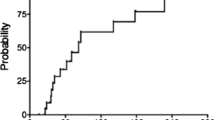Abstract
Purpose
While cavernous angioma (CVA) after cranial irradiation has been documented, its development after high-dose chemotherapy with autologous peripheral blood stem cell transplantation (PBSCT) has not. We present a patient with desmoplastic/nodular medulloblastoma (DNMB) associated with anhidrotic ectodermal dysplasia (AED) who developed CVA 2 years after high-dose chemotherapy and PBSCT.
Methods
A 1-year-old boy with ingravescent vomiting was admitted to our institute. He presented with a large head, a depressed nasal bridge, low-set ears, thick lips with peg-shaped teeth, hypohidrosis, sparse hair, thin atrophic skin, scaly dermatitis with frontal bossing, and a bulging anterior fontanel. Neuroradiological examination revealed multiple cerebellar masses with heterogeneous enhancement and speckled calcifications and severe obstructive hydrocephalus. The histological diagnosis of surgical specimens was DNMB, and he underwent postoperative multiple-drug chemotherapy with autologous PBSCT. The outcome was favorable and he did not undergo radiotherapy.
Results
After 2 years, intracranial hemorrhage was detected at his regular radiological check-up and he again underwent surgery. The histological diagnosis was CVA.
Conclusions
To our knowledge, this is the first report of AED-associated DNMB and CVA.



Similar content being viewed by others
References
Yamasaki F, Takayasu T, Nosaka R, Kenjo M, Akiyama Y, Tominaga A, Sugiyama K, Kobayashi M, Kurisu K (2015) The postirradiation incidence of cavernous angioma is higher in patients with childhood pineoblastoma or primitive neuroectodermal tumors than medulloblastoma. Childs Nerv Syst 31:901–907
Watanabe Y, Yamasaki F, Nakamura K, Kajiwara Y, Takayasu T, Hirose K, Amatya VJ, Sugiyama K, Kobayashi M, Kurisu K (2013) Desmoplastic/nodular medulloblastoma associated with anhidrotic ectodermal dysplasia. Int Cancer Conf J 2:178–182
Clarke A (1987) Hypohidrotic ectodermal dysplasia. J Med Genet 24:659–663
Priolo M, Silengo M, Lerone M, Ravazzolo R (2000) Ectodermal dysplasias: not only ‘skin’ deep. Clin Genet 58:415–430
Rigamonti D, Hadley MN, Drayer BP, Johnson PC, Hoenig-Rigamonti K, Knight JT, Spetzler RF (1988) Cerebral cavernous malformations. Incidence and familial occurrence. N Engl J Med 319:343–347
Lew SM, Morgan JN, Psaty E, Lefton DR, Allen JC, Abbott R (2006) Cumulative incidence of radiation-induced cavernomas in long-term survivors of medulloblastoma. J Neurosurg 104:103–107
Vinchon M, Leblond P, Caron S, Delestret I, Baroncini M, Coche B (2011) Radiation-induced tumors in children irradiated for brain tumor: a longitudinal study. Childs Nerv Syst 27:445–453
Burn S, Gunny R, Phipps K, Gaze M, Hayward R (2007) Incidence of cavernoma development in children after radiotherapy for brain tumors. J Neurosurg 106:379–383
Kerbel RS, Viloria-Petit A, Klement G, Rak J (2000) ‘Accidental’ anti-angiogenic drugs. Anti-oncogene directed signal transduction inhibitors and conventional chemotherapeutic agents as examples. Eur J Cancer 36:1248–1257
Belotti D, Vergani V, Drudis T, Borsotti P, Pitelli MR, Viale G, Giavazzi R, Taraboletti G (1996) The microtubule-affecting drug paclitaxel has antiangiogenic activity. Clin Cancer Res 2:1843–1849
Vacca A, Iurlaro M, Ribatti D, Minischetti M, Nico B, Ria R, Pellegrino A, Dammacco F (1999) Antiangiogenesis is produced by nontoxic doses of vinblastine. Blood 94:4143–4155
Clements MK, Jones CB, Cumming M, Daoud SS (1999) Antiangiogenic potential of camptothecin and topotecan. Cancer Chemother Pharmacol 44:411–416
Miller KD, Sweeney CJ, Sledge GW Jr (2001) Redefining the target: chemotherapeutics as antiangiogenics. J Clin Oncol 19:1195–1206
Doll DC, Yarbro JW (1992) Vascular toxicity associated with antineoplastic agents. Semin Oncol 19:580–596
Licciardello JT, Moake JL, Rudy CK, Karp DD, Hong WK (1985) Elevated plasma von Willebrand factor levels and arterial occlusive complications associated with cisplatin-based chemotherapy. Oncology 42:296–300
Roca E, Bruera E, Politi PM, Barugel M, Cedaro L, Carraro S, Chacon RD (1985) Vinca alkaloid-induced cardiovascular autonomic neuropathy. Cancer Treat Rep 69:149–151
Hansen SW, Olsen N, Rossing N, Rorth M (1990) Vascular toxicity and the mechanism underlying Raynaud’s phenomenon in patients treated with cisplatin, vinblastine and bleomycin. Ann Oncol 1:289–292
Moseley PL, Hemken C, Hunninghake GW (1986) Augmentation of fibroblast proliferation by bleomycin. J Clin Invest 78:1150–1154
Poussaint TY, Siffert J, Barnes PD, Pomeroy SL, Goumnerova LC, Anthony DC, Sallan SE, Tarbell NJ (1995) Hemorrhagic vasculopathy after treatment of central nervous system neoplasia in childhood: diagnosis and follow-up. AJNR Am J Neuroradiol 16:693–699
Ahles TA, Saykin AJ (2007) Candidate mechanisms for chemotherapy-induced cognitive changes. Nat Rev Cancer 7:192–201
Cheung YT, Chui WK, Chan A (2012) Neuro-cognitive impairment in breast cancer patients: pharmacological considerations. Crit Rev Oncol Hematol 83:99–111
van Dam FS, Schagen SB, Muller MJ, Boogerd W, vd Wall E, Droogleever Fortuyn ME, Rodenhuis S (1998) Impairment of cognitive function in women receiving adjuvant treatment for high-risk breast cancer: high-dose versus standard-dose chemotherapy. J Natl Cancer Inst 90:210–218
Acknowledgments
We thank Ursula Petralia for editorial review. This study was partly supported by the Japan Society for the Promotion of Science Grant-in-Aid for Scientific Research (C) number 25462262.
Conflict of interest
The authors have no conflicts of interest to disclose.
Author information
Authors and Affiliations
Corresponding author
Rights and permissions
About this article
Cite this article
Yamasaki, F., Takayasu, T., Nosaka, R. et al. Cavernous angioma after chemotherapy for desmoplastic/nodular medulloblastoma associated with anhidrotic ectodermal dysplasia. Childs Nerv Syst 32, 395–398 (2016). https://doi.org/10.1007/s00381-015-2848-6
Received:
Accepted:
Published:
Issue Date:
DOI: https://doi.org/10.1007/s00381-015-2848-6




